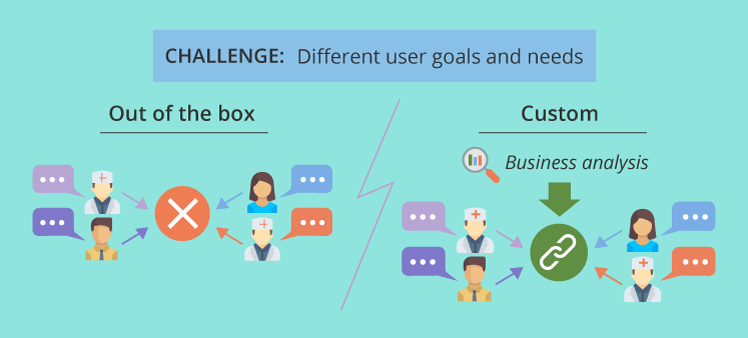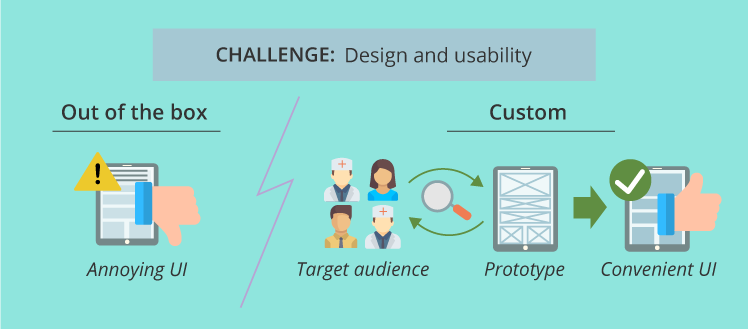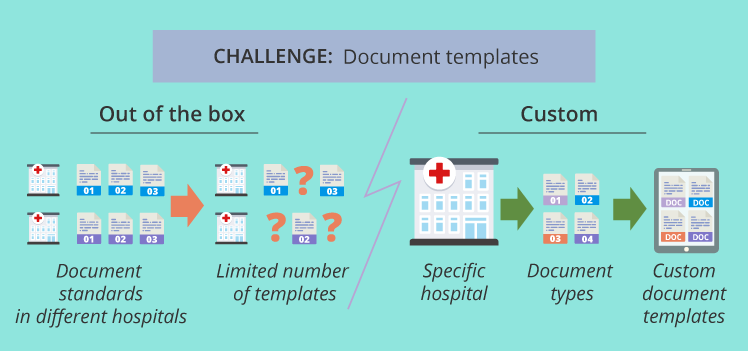Custom Hospital Apps vs. Off-the-Shelf Healthcare Solutions

If we look back about 5-7 years, the very first representatives of the healthcare industry in the mobile sphere were lifestyle patient apps. The overwhelming majority of these apps were ready-made products, introduced to the vast market and distributed via online app stores. Quite simple in functionality, such apps had the form of basic diaries, calculators, or collections of tips. In fact, they exist to this day and are a part of a successful app category with a diverse and large target audience of health-conscious users.
However, when we try to apply a similar out-of-the-box approach to mobile software targeted at healthcare professionals, it's hard to imagine the same level of success. Hospital caregivers' tasks require solutions that are a lot more complex than a water intake controlling tool and their needs vary enormously across the industry.
In this article, we talk about five challenges related to the use of mobile software in healthcare and uncover the differences in the development approaches of off-the-shelf products and custom hospital apps.
Challenge: Different user goals and needs
Unlike the general target audience of lifestyle apps, the users of hospital apps have very diverse needs that vary from specialization to specialization. What's more, even the health professionals who work closely together and provide care to the same patients, may have different objectives when using an app.
For example, a nurse may need to input the latest lab test results, while a physician may want to compare them to the previous ones or show them to a patient in the form of a neat graph. These are two completely different user goals, and they should be taken into account at the very first stages of development.
Off-the-shelf product developers can't afford to delve into the specifics that can eventually either narrow the target audience down or overload functionality and make an app too difficult to use. In the end, they deliberately choose to create products that address only most basic user needs.

Custom approach
Business analysis is an indispensable part of any custom development project. By collecting data on the workflow, the goals, and the needs of a specific group of future users, custom app developers are able to define all the possible functionality scenarios and implement them in an app. This way, a solution turns out flexible and effective, while remaining easy to perceive and navigate.
Challenge: Design and usability
Many off-the-shelf hospital apps prove to be highly inconvenient in use. When reviewing such apps, healthcare professionals point out the unstable navigation in drop-down menus and the lack of color contrast in the UI, which makes app content poorly visible under the peculiar hospital lighting conditions. Since instead of helping out such hospital apps are mostly annoying their users, they are quite quickly discarded.

Custom approach
To ensure better usability, a deep insight into the target audience is necessary. In custom hospital app development, designers gather information about the future users' specific working conditions before creating the very first interface layouts. They also closely cooperate with the target audience during the prototyping stage and create the best experience with the help of real user feedback. After all, a good interface isn't about the ease of learning how to use it, but rather the ease of applying already existing skills and work methods to the mobile environment.
Challenge: Document templates
Caregivers have to work with lots of documents, now even more than ever before. The documentation standards vary from facility to facility, from state to state, and change over time. Out-of-the-box solutions simply can't keep up with the pace and offer all the existing standards, so they include only a limited number of templates that can be used across the industry.

Custom approach
When an app is developed for a certain hospital facility (let alone, a department), there's a more or less fixed number of document types. This allows developers to create templates for all the relevant papers and implement them in an app. What's more, all the document standards are state- and facility-specific in this case. So, each template can be as much complete as possible and won't require additional editing every time a healthcare professional has to fill it in.
Challenge: Integration
Integrating a hospital app with an in-house healthcare system means allowing the app to live up to its full potential. Direct communication with EHR system, for one, can turn it into a safe and portable outlet to all the necessary patient data.
However, integration is only easy when both the out-of-the-box mobile app and the in-house system are developed by the same vendor. When the solutions are owned by different companies, setting up data exchange can be difficult or even impossible. The reason is that both pieces of software have their own, often incompatible, security measures that prevent integration, and their owners would be unwilling to disclose them. Also, while Health Level 7 (HL7) is a global and widely accepted standard, the specific nature of software can sometimes undermine it.

Custom approach
No matter if the in-house system is an off-the-shelf product or a third party solution, a vendor of a custom hospital app can always ensure smooth integration by developing a workaround. That is, create middleware that allows a mobile app to communicate with the rest of the healthcare software system. Along with managing integration, middleware is also a backend for a mobile app, so it takes over a part of the app logic, making it more agile and lightweight.
Challenge: Algorithms
In the past few years, out-of-the-box mobile solutions started to promote the use of special algorithms meant to analyze data and either take action in accordance to the results or offer a user to do so. For instance, these algorithms can suggest prescribing certain medication based on the established diagnosis. Or vice versa: ban it from the prescription because of the incompatibility with some other prescribed medication or a patient's allergy.
The concept is, by all means, promising, but doesn't work well in practice yet. There're simply too many possibilities of different combinations that such algorithms must know and understand in order to make trusted suggestions. With the advance of machine learning, they probably will be able to do it someday, but right now most of their suggestions/actions turn out to be irrelevant or incorrect. Eventually, many caregivers tend to opt out of using the algorithms altogether.

Custom approach
Since the core problem of the algorithms' ineffectiveness lies in the infinite amount of data they should be able to recognize, targeting a specific healthcare specialization, practice and know-how of a healthcare provider can create favorable conditions for them. Developers can train the algorithms using the knowledge base of the department or of the entire facility. Limited but focused knowledge will make the algorithms a lot more accurate and successful in predictions and precautions.
Summing up
Because it is targeted at a broader audience, an out-of-the-box mobile solution fails to address many of the healthcare challenges. Unlike it, a custom hospital app is laser-focused on a specific customer, their individual goals, working conditions, and workflow patterns. By bringing in flexibility, great user experience, tailored functionality and smooth integration, custom hospital apps are clearly more effective in satisfying the needs of healthcare professionals.

